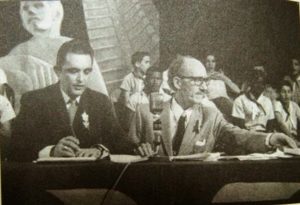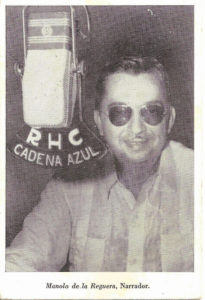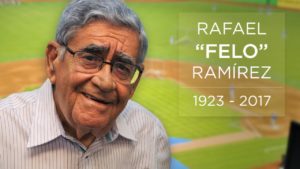According to historical reviews, the first chronicle of a baseball game was published in Havana daily El Artista, in December of 1874, the author describes details of what happened in an exhibition meeting between the Havana and Matanzas teams, celebrated in the well-known Palmar de Junco de Matanzas.
José Manuel Govín, founder and director of the newspaper El Mundo, was the precursor to report sporting events on the pages of his diary and put in the hands of the notable costumbrista Víctor Muñoz sports responsibility. These works were always accompanied by illustrations by the notable cartoonist Conrado Massaguer, who gave life to unforgettable portraits of famous players and pelotaris (jai-alai or Basque pelota, very popular then and until the triumph of the revolution).
In 1922 the radio appeared, which in scope, extension and narrative thoroughness was the most at that time. Through the radio waves it was possible to listen to whatever happened. But the news spaces gave much greater coverage to the rented athletes, fundamentally peloteros and boxers, and very limited attention to the exploits of the billiard player Alfredo de Oro, multiple world champion in the 1920s, or the chess player José Raúl Capablanca, champion World Chess Championship from 1921 to 1927.
During the 1920s and 1930s attempts were made to bring the games to the fans, mainly ball, the most popular sport, despite the interests that opposed this modality, because they affected the business, as many people preferred listen to the game on the radio, as happened later with television.
In the 1940s, ball transmissions began to proliferate on the radio, particularly through the RHC Cadena Azul, COCO, CMW Onda Deportiva, CMCZ, Radio Salas and La Mil Diez. The first narrators, who later gained popularity on a national scale, were, among others, René Cañizares (Kañita), Manolo de la Reguera (the champion), Orlando Sanchez Diago and Cuco Conde. Later, Felo Ramírez, Rubén Rodríguez, Gonzalo López Silvero, Rafael Rubí, Fernando Menéndez, Eddy Martín and Gabino Delgado joined. By the way, Manolo de la Reguera said that when 222 came on the board, two balls, two strikes and two outs, the team at bat would not make more runs in that episode. Analyzing the situation and taking into account that an average hitter hits a hit between 3 and 4 turns, the possibility that Manolo de la Reguera was right is very high.
According to one of Eddy Martin’s books, both Manolo Serrano and Manolo Ortega, when they were broadcasters of CMQ and Mil Diez, ventured into sports narration, but finally devoted themselves to the voiceover, and today they are figures of reference in history of the Cuban phrase. Similar consideration must be made with Eddy Martin himself and some others we will see.
Until 1949 the transmissions of sporting events consisted of describing the event and offering commercial announcements, which were included during the transmission, but it was precisely in the professional ball season of that year that the Union Radio station, inaugurated the era of the narrator and commentator. He did it with Felo Ramírez in the narration and the journalist René Molina in the comments. The commercial announcements included them in the voice of the speaker Roberto Canela. With this Union Radio gave life to a new style of sports broadcasts.
The narrators and commentators used, through channel 4 Union Radio Television were Felo Ramírez, René Molina, Orlando Sánchez Diago and Rubén Rodríguez. While on channel 6, CMQ television, they did Gabino Delgado, Jess Losada. Fernando Menéndez, and Cuco Conde. On some occasions, fundamentally, on weekends, the American-Argentine-Cuban Buck Canel did it.
There are many who can be considered the best sports narrator of all time in Cuba. Felo Ramírez, Cuco Conde, Rubén Rodríguez, Bobby Salamanca, Roberto Pacheco, Ramón “Pity” Rivera, René Navarro and Eddy Martin, all of them undoubtedly were prominent in their profession. Each of them, with his particular style, left an imprint in the history of the Cuban sports narrative.
LOS NARRADORES DEPORTIVOS CUBANOS. BREVE HISTORIA.
Según las reseñas históricas, la primera crónica de un juego de béisbol fue publicada en el cotidiano habanero El Artista, en diciembre de 1874, el autor describe detalles de lo sucedido en un encuentro de exhibición entre los equipos Habana y Matanzas, celebrado en el conocido Palmar de Junco de Matanzas.
José Manuel Govín, fundador y director del periódico El Mundo, fue el precursor de reportar eventos deportivos en las páginas de su diario y puso en manos del notable costumbrista Víctor Muñoz la responsabilidad deportiva. Estos trabajos siempre estuvieron acompañados de ilustraciones del notable dibujante Conrado Massaguer, quien dio vida a inolvidables retratos de famosos peloteros y pelotaris (jai-alai o pelota vasca, muy popular entonces y hasta el triunfo de la revolución).
En 1922 apareció la radio, la que en alcance, extensión y minuciosidad narrativa era lo máximo en esos momentos. A través de las ondas radiales fue posible escuchar en cualquier sitio cuanto ocurría. Pero los espacios noticiosos dieron mucha mayor cobertura a los atletas rentados, fundamentalmente peloteros y boxeadores, y muy limitada atención a las hazañas del jugador de billar Alfredo de Oro, múltiple campeón mundial en la década de 1920, o al ajedrecista José Raúl Capablanca, campeón mundial de ajedrez de 1921 a 1927.
Durante la década de 1920 y 1930 se realizaron intentos para llevarles a los aficionados los juegos, fundamentalmente de pelota, el deporte más popular, a pesar de los intereses que se oponían a esta modalidad, pues les afectaba el negocio, ya que mucha gente prefería escuchar el juego por radio, como ocurrió también después con la televisión.
En la década de los cuarenta comenzaron a proliferar las transmisiones de pelota por la radio, en particular a través de la RHC Cadena Azul, COCO, CMW Onda Deportiva, CMCZ, Radio Salas y la Mil Diez. Los primeros narradores, que después alcanzaron popularidad a escala nacional, fueron, entre otros, René Cañizares (Kañita), Manolo de la Reguera (el campeón), Orlando Sánchez Diago y Cuco Conde. Más tarde se sumaron Felo Ramírez, Rubén Rodríguez, Gonzalo López Silvero, Rafael Rubí, Fernando Menéndez y Gabino Delgado. Por cierto Manolo de la Reguera decía que cuando en la pizarra aparecía el 222, dos bolas, dos strikes y dos outs, el equipo al bate no haría más carreras en ese episodio. Analizando la situación y tomando en cuenta que un bateador promedio pega un hit entre 3 y 4 turnos, la posibilidad de que Manolo de la Reguera tuviera razón es muy alta.
Según narra en uno de sus libros Eddy Martin, tanto Manolo Serrano como Manolo Ortega, cuando eran locutores de CMQ y de Mil Diez, incursionaron en la narración deportiva, pero se dedicaron finalmente a la locución, y hoy son figuras de referencia en la historia de la locución cubana. Similar consideración hay que hacer con el propio Eddy Martin y algunos otros que veremos.
Hasta 1949 las transmisiones de eventos deportivos consistían en describir el evento y ofrecer anuncios comerciales, que eran incluidos durante la transmisión, pero fue precisamente en la temporada de pelota profesional de ese año que la emisora Unión Radio, inauguró la era del narrador y comentarista. Lo hizo con Felo Ramírez en la narración y el periodista René Molina en los comentarios. Los anuncios comerciales los incluían en la voz del locutor Roberto Canela. Con ello Unión Radio dio vida a un nuevo estilo de transmisiones deportivas.
Los narradores y comentaristas utilizados, por el canal 4 Unión Radio Televisión fueron Felo Ramírez, René Molina, Orlando Sánchez Diago y Rubén Rodríguez. Mientras por el canal 6, CMQ televisión, lo hacían Gabino Delgado, Jess Losada. Fernando Menéndez, y Cuco Conde. En algunas ocasiones, fundamentalmente, los fines de semana, lo hacía el norteamericano-argentino-cubano Buck Canel.
Son muchos los que pueden ser considerados el mejor narrador deportivo de todos los tiempos en Cuba. Felo Ramírez, Cuco Conde, Rubén Rodríguez, Bobby Salamanca, Roberto Pacheco, Ramón “Pity”Rivera, René Navarro y Eddy Martin, todos ellos sin duda fueron destacados en su profesión. Cada uno de ellos, con su estilo particular, dejó una huella en la historia de la narración deportiva cubana.
Agencies/MemoriasCubanas/Carlos Rodriguez/Internet Photos/ Arnoldo Varona/ TheCubanHistory.com
THE CUBAN HISTORY, HOLLYWOOD.










